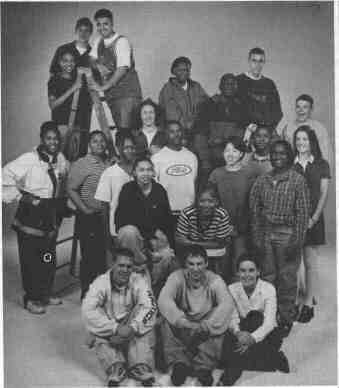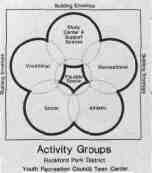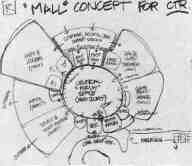The Making of a Teen Center
In the future, centers for teens will be planned, designed, built and financed by teens
BY GAYLE M. DIXON, ROBERT C. ROBICSEK, AIA, NCARB, AND KELLIE A. FARRAR

Young adults today face gang violence, teenage pregnancy, drug and alcohol abuse and education and career choices. Along with these real-life issues comes another: society's unresolved stereotyping of teens.
A vast majority of adults share an overwhelming negative view of today's youth. When asked how to describe them, adults believe our teens are rude, irresponsible and wild. Newspaper headlines on teenage pregnancy and substance abuse, juvenile crime and suicide inundate our lives. Clearly such dialogue can lead recreation professionals concerned with this growing population to feel disheartened and to ask themselves, "What's the use?" "Can we really do anything to help?"
At the Rockford Park District, we asked and we found out what we can do to help. We offered teens, ages 14 to 18, an opportunity to advise park district leaders, including our director, on issues that concern todays youth. Our meetings were held during the school day, which allowed the teens an opportunity to break away from their daily doldrums and socialize with their peers. We also learned dial supplying "teen food" immensely increased our attendance.
In a continued effort to create a forum in which teens could discuss and take action on teen-related issues, the Youth Recreation Council (YRC) was estab-
November/December 1997 / 29
SPECIAL FOCUS
| Photograph on page 29: Members of Rockford's 1996-1997 "Youth Recreation Council (YRC). The YRC was established in 1989 to create a forum in which teens can discuss their issues and lake action. Photo by Gary L. Geiger. |
lished in 1989. The YRC continues as a Rockford Park District sponsored organization with emphasis on recreation. The Council is comprised of volunteer student representatives from private and public schools throughout the Rockford area. The group elects officers, selects committees and works from an agenda at their bimonthly meetings.
The objectives of the Youth Recreation Council are to serve in an advisory capacity on issues of concern to the teens; create, plan and implement programs and projects; promote the development of leadership qualities; and, work with existing recreational agencies, youth groups and recreation programs to establish more youth programming and participation. The YRC also is involved with sponsoring and hosting dances, talent shows, teen summits, youth forums, and ongoing recreation programs.
It was the philosophy of the 1990-1992 YRC to conceive a place that the teens of Rockford can call their own; a nurturing place for recreation, arts, social interaction and education. A place run by teens for teens, where teens can be leaders. A place that teens will respect through a sense of ownership and sharing.
"Active teen involvement is the key to success for the YRC," says Clarence Hicks, deputy director of recreation services for the Rockford Park District.
"We share mutual respect, we listen to the teens and take their thoughts and ideas seriously. The teens are the driving force and they are full partners in everything we do."
Although it took two years to develop, the dream to have a "teen designated" space became a reality with the completion of The Getaway Teen Playground, in 1992. The YRC planned, designed and built the playground. Raising $200,000 for tools, materials, volunteers and food was a major feat. The Getaway Teen Playground, a first in the nation, was modeled after two successful youth Playworks projects in Rockford.
The YRC remains the controlling force of what happens at The Getaway, responsible for retrieving input from local schools and formulating the direction in which the playground proceeds. They are involved in selecting peak teen use times including supervised hours, programmed activities and length of season. Each fall, the YRC forms a new council, which maintains the previous group's short- and long-term goals. The teens are encouraged to form, communicate and debate their ideas in constructive ways.
One of the primary goals of the 1994-1996 season was to conduct a needs assessment to achieve consensus concerning the desire for a centrally located, year-round, full-service teen center available to all the youth in the community.
"Teens want a place to have for their own, a relaxed atmosphere where you feel safe, a place to have fan, do what you want and hang out with your friends," says Carrie Keeling, one of the original teen center steering committee members.
"The possibilities for the center are endless. We start talking about this and those conversations can go on for hours."
It was the goal of the YRC to take this project seriously and develop a comprehensive plan. The YRC's preliminary research included: exploring existing youth centers in the Rockford area to determine what facilities and programs were offered; outlining and prioritizing the programs and services that the YRC would offer in the new teen center; circulating a petition to verify the need among their peers; and presenting their ideas to park officials at an organized Teen Summit.
"We had difficulties finding a model of what we wanted," says Olivia Rogers, the 1995-1996 YRC chair.
"We saw teen rooms with game tables and big screen TVs within community centers, or separate individual dance clubs, but we're talking about a unique, fan, large facility that is designed for teens."
According to Erin Gilbert, the 1996-1997 chair: "My vision for the teen center is idealistic more that anything else. I see it as a physical, emotional, athletic, academic center for teens."
The teen center concept was pursued by youth and community leaders alike. The Rockford mayors "Blueprint for Rockford's Future" identified the need for a centrally located teen center.
In the fall of 1995, the Rockford Park District board of commissioners agreed to fund a Teen Center Feasibility Study as recommended by the YRC. The teens were the driving force behind the
|
America's Children Are At Risk • 15 million American children are at risk. • More teens than ever--- a half million --- belong to gangs. • Juvenile crime has increased, while crime overall has gone down. Juvenile homicide rates have tripled in a decade. • Each at-risk child who ends up in jail costs society $1 million over a lifetime. • Nearly 37 percent of Illinois 12th graders have used marijuana. • About 1 million teenage girls get pregnant every year. •Three million kids are abused every year. • At-risk kids who get help are 46 percent less likely to use drugs; 27 percent less likely to use alcohol; and 52 percent less likely to miss school or act violently in school. — 1997 Presidents' Summit for America's Future |
30 / Illinois Parks and Recreation
THE MAKING OF A TEEN CENTER
first step of this project. The YRC and its representatives became involved by soliciting requests for proposals from architects statewide. They were responsible for creating the architectural selection criteria and for reviewing almost a dozen proposals. After narrowing the selection down to four firms, the teens conducted weekend interviews and presented their recommendation to the park board.
While preparing for the interview with the YRC, Robert Robicsek, AIA, senior vice president of Environ, Inc.—the firm that ultimately was retained for die project—says he thought: "How seriously do you take five teens on a Saturday morning?"
"The answer is very seriously, if you want to gain their respect," says Robicsek, who reflects back on this experience as one of the most unique and challenging of his 17-year career. Environ, Inc., is a architecture, planning and design firm based in Chicago.
The teens ran the interview with the adults acting as facilitators, assisting with keeping the interview on track. It was made very dear at the start that the teens would ask most of the questions and make the final decision as to which firm will be retained for the project. The teens had prepared their own list of questions to ask each firm.
One of the most important questions they asked was how Environ, Inc., would work and communicate with the YRC and the teens they represent in formulating a concept for the teen center.
According to Robicsek: "A unique aspect of my working relationship with the YRC was the brutal honesty of these teens. They express themselves freely and honesty to each other, park staff and their consultants. They tell it like it is and expect you to do the same.
"Listening to your client is a fundamental rule in the architectural industry," says Robicsek.
"When your client is a group comprised of teens such as the YRC, it is imperative. Through the teens, we learned about racial and social issues impacting the project, what spaces are deemed cool and 'uncool,' and their feelings about the role(s) of adults in the future teen center."
Once the design team understood the various external factors affecting the project, they began to develop a comprehensive list of activities and functions. Seeking the input of various local, community, artistic, and social groups was important in the program development process. Through focus groups, round-table discussions, and a teen survey, program types and activity spaces were determined. The survey, sent to more than 300 local teens, received a response rate of over 35 percent. With the information gathering phase complete, the design of the center began to take shape.
Through the space programming and space planning needs studies, a specific design emerged: a central activity space or "spine" comprised of a food court and central lounge/lobby, which would form the core of the teen "forum." Most noisy spaces and major teen activity areas open to this main space featuring a high ceiling, lots of natural light and existing spatial energy. From the central area, the building "sprouts wings" in two directions: an athletic wing and an educational/arts wing.
"We worked with the teens to make as many spaces within the building, flexible and adaptable to future uses," says Robicsek.
"We also anticipated the use of some of the spaces by other community groups during off-peak teen use hours. For example, a large multipurpose classroom/meeting area can be used as a daycare center during the day and the library can be used as a job skills training center. The overall image of the building is one of a fun yet solid place, giving permanence without being boring."
The teen center project was presented on several occasions to the park board. The YRC's message was preached to several adult bodies, spreading the view that this project is not only good for the area's teens but is a hands-on exercise in building teen leadership!
On October 8, 1996, the park board approved the study. The YRC is currently pursuing a variety of funding options a well as working with the board towards further development of the study. The YRC is currently on its third chairperson, a student who was only a freshman when the process began. New committees have been formed to create next action steps, time lines, fundraising options, and marketing and public relations strategies.
If the YRC maintains their momentum and "keeps their eye of the prize," the future of the new Rockford teen center is a solid one.
GAYLE M. DIXON
is a supervisor for recreation at the Rockford Park District and an advisor to the Youth Recreation Council.
ROBERT C. ROBICSEK. AIA. NCARB
is a senior vice president and principal for Environ, Inc. an architecture, planning and design firm, and is an associate member of the Illinois, Park and Recreation Association.
KELLIE A. FARRAR
is the director or marketing for Environ, Inc. For more information, contact Environ Inc. at 312.951.8863 or environ@flash.net.
|
|
|
November/December 1997 / 31

